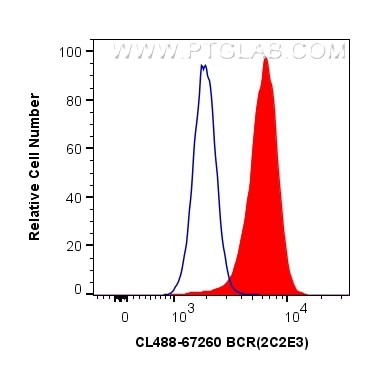Validation Data Gallery
Tested Applications
| Positive FC (Intra) detected in | K-562 cells |
| Positive FC detected in | K-562 cells |
Recommended dilution
| Application | Dilution |
|---|---|
| Flow Cytometry (FC) (INTRA) | FC (INTRA) : 0.40 ug per 10^6 cells in a 100 µl suspension |
| Flow Cytometry (FC) | FC : 0.40 ug per 10^6 cells in a 100 µl suspension |
| It is recommended that this reagent should be titrated in each testing system to obtain optimal results. | |
| Sample-dependent, Check data in validation data gallery. | |
Product Information
CL488-67260 targets BCR in FC (Intra) applications and shows reactivity with Human, rat samples.
| Tested Reactivity | Human, rat |
| Host / Isotype | Mouse / IgG2b |
| Class | Monoclonal |
| Type | Antibody |
| Immunogen | BCR fusion protein Ag28953 相同性解析による交差性が予測される生物種 |
| Full Name | breakpoint cluster region |
| Calculated molecular weight | 143 kDa |
| Observed molecular weight | 150-160 kDa |
| GenBank accession number | BC066122 |
| Gene Symbol | BCR |
| Gene ID (NCBI) | 613 |
| RRID | AB_3084332 |
| Conjugate | CoraLite® Plus 488 Fluorescent Dye |
| Excitation/Emission maxima wavelengths | 493 nm / 522 nm |
| Form | Liquid |
| Purification Method | Protein A purification |
| UNIPROT ID | P11274 |
| Storage Buffer | PBS with 50% glycerol, 0.05% Proclin300, 0.5% BSA , pH 7.3 |
| Storage Conditions | Store at -20°C. Avoid exposure to light. Stable for one year after shipment. Aliquoting is unnecessary for -20oC storage. |
Background Information
The Bcr gene, mapping on chromosome22, was orginally identified by its presence in the chimeric Bcr-Abl oncogene. The Bcr gene encodes for the break point cluster region protein(Bcr). Although the BCR-ABL fusion protein has been extensively studied, the function of the normal BCR gene product is not clear. The protein has serine/threonine kinase activity and is a GTPase-activating protein for RAC1 and CDC42. A chromosomal aberration involving BCR has been found in patients with chronic myeloid leukemia.
Protocols
| Product Specific Protocols | |
|---|---|
| FC protocol for CL Plus 488 BCR antibody CL488-67260 | Download protocol |
| Standard Protocols | |
|---|---|
| Click here to view our Standard Protocols |
